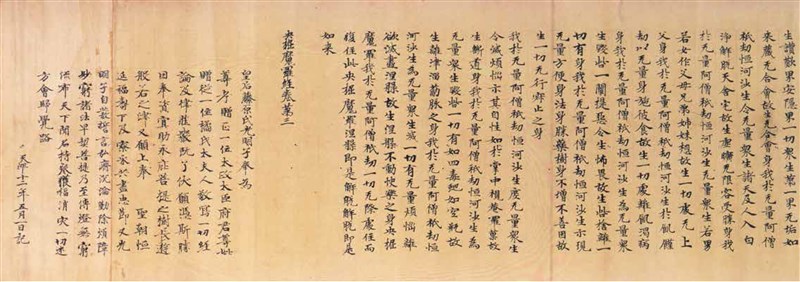央掘魔羅経巻第三(五月一日経)
- 奈良
- 奈良時代
- 8c
- 紙本墨書
- H-26.5 W-954.7
- 所蔵
- 重要美術品
奈良時代 8世紀
紙本墨書
縦:26.5cm 全長(表紙共):954.7cm
光明皇后(701~760)が亡父藤原不比等と亡母県犬養三千代の追福のために発願し,
併せて天皇の御代の福寿と臣下の忠節,さらに自らは迷い苦しむ衆生の救済と法灯の無窮を誓って発願書写せしめた一切経のうちの一巻。願文の末尾に「天平十二年五月一日記」という日付があるところから,「五月一日経」と通称されている。
その写経事業は,正倉院文書「写経請本帳」(『大日本古文書』巻七)によって,願文の日付をさかのぼること4年前の天平8年(736)9月29日に皇后宮職の写経所で始められ写経のための底本は,法相宗第四伝とされる玄ム和上将来の経論が用いられたことがわかる。『続日本紀』巻第十六によると,玄ムは霊亀2年(716)に入唐し,天平7年(735)に帰朝して,経論五千余巻および諸仏像をもたらしている。経論五千余巻とは,これ以後の一切経を書写する際の有力な基準となった唐の智昇撰『開元釈教録』(開元 18年〈 730〉成立)入蔵の五千四十八巻の一切経のことである。『開元釈教録』撰述後5年にして入蔵の一切経が将来され,これが「五月一日経」の底本に用いられたのである。
書写事業は,天平12年5月1日に完了したわけではなく,天平勝宝元年(749)頃まで続けられ,最終的には『開元釈教録』に入蔵されていない典籍も含めて七千巻余の経典が書写されたとみられている。
その書風は,15年前後の長きにわたって書写され続けた一切経であるため一様ではないが,細みの筆線の遒勁な写経体としてとくに珍重されており,しなやかさに加えて充実しきった点画のものが多い。書風に関しては,わが国の素紙経のなかで「五月一日経」の右に出るものはないと言ってもよい。
現在でも,正倉院聖語蔵に七百五十巻,巷間に約二百五十巻の合わせて千巻近くが現存しており,奈良時代の一切経の遺品としては,現存する数が最も多い一切経である。まさに「五月一日経」は,質・量ともに奈良朝写経を代表する遺品なのである。(赤尾)
Catalogue Entry
(known as May 1st Sutra)
Nara period, 8th century
Handscroll, ink on paper
Height, 26.5cm;
overall length (including cover sheet), 954.7cm
This is one scroll from a set of the entire sutra canon (Issaikyo) commissioned by Empress Komyo (701-760) in memory of her deceased father, Fujiwara Fuhito, and her deceased mother, Agata-no-Inukai Michiyo, to pray for the happiness of the generations of emperors, the loyalty of their retainers, the salvation of the general populace from their confusion and hardships, and as a pledge to the eternity of the Buddhist faith. The end of her dedicatory inscription notes that it was "inscribed on the 1st day of the 5th month of the 12th year of the Tempyo era," and thus this sutra has come to be known as the "May 1st Sutra."
According to the Shosoin text Shakyo Shohon-cho (Dainippon komonjo, volume 7), the process of copying all of these sutras began 4 years prior to the date of the inscription, on the 29th day of the 9th month of 736 (Tempyo 8) in the sutra copy offices of the Empress's palace. The version of the sutras by Hsuan-fang (Genbo), the fourth generation patriarch of the Hosso sect, was used as the basis for this copy. According to volume 16 of the Shoku nihongi, Genbo went to Tang China in 716, and after gathering some 5,000 or more scrolls of sutras and commentaries and various sculpted Buddhist images, he returned to Japan in 735 (Tempyo 7). These 5,000 plus sutra scrolls then refer to the Kaigen Shakkyo-roku (edited by Chisho and established in K'ai Yu∃an 18, 730) as the authoritative basis for the copying of the entire sutra literature. This Buddhist canon consists of 5,048 scrolls of sutras and was the basis for the "May 1st Sutra."
The process of copying all of these sutras did not end on the 1st day of the 5th month, but rather continued until around 749 (Tempyo Shoho 1). With the addition of books and texts not included in the Issaikyo, the project consisted of the copying of more than 7,000 scrolls.
The calligraphy style of this sutra was of course not limited to a single style or hand, given that the copy process continued for approximately 15 years and included the entire Buddhist canon. In any event, many of these scrolls are prized for their powerful strokes of sutra script style calligraphy drawn in thin brush lines and their supple lines and carefully applied dotting. In terms of calligraphy style, there is no finer example of a Japanese plain-paper sutra than the "May 1st Sutra."
At present, there are 750 scrolls in the Shosoin Sacred Text Repository, and approximately 250 scrolls are dispersed in the rest of the world. This extant group of close to 1,000 scrolls represents the largest extant group of Nara period Issaikyo sets. Indeed, the "May 1st Sutras" are representative examples of Nara sutra copies in terms of both quantity and quality. EA
